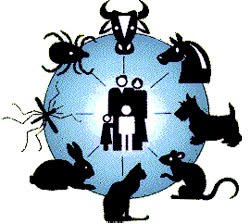***********************************************************
A ProMED-mail post
ProMED-mail is a program of the
International Society for Infectious Diseases
Date: Thu 27 Oct 2011
Source: Harnesslink.com [edited]
A 3-year-old horse from Gloucester County was euthanized on 20 Oct
2011 after contracting eastern equine encephalitis (EEE), a serious,
mosquito-borne illness in horses.
"With an increase in the state's mosquito population due to rain
storms in the last couple of months, horse owners must be vigilant in
protecting their animals from diseases spread by mosquitoes," said New
Jersey secretary of agriculture Douglas H Fisher. "Horse owners should
contact their veterinarians to have their animals vaccinated against
these illnesses."
This deadly disease is easily prevented by vaccination. Effective
equine vaccines for EEE and another mosquito-borne disease, West Nile
virus (WNV), are available commercially. Horse owners should contact
their veterinarians if their horses are not already up-to-date on
their vaccinations against both EEE and West Nile virus.
The Gloucester County stallion's vaccination status against EEE is
unknown with no report of vaccination in 2011.
EEE causes inflammation of the brain tissue and has a significantly
higher risk of death in horses than West Nile virus infection. West
Nile virus is a viral disease that affects horses' neurological
systems. The disease is transmitted by mosquito bite. The virus cycles
between birds and mosquitoes with horses and humans being incidental
hosts. EEE infections in horses are not a significant risk factor for
human infection because horses (like humans) are considered to be
"dead-end" hosts for the virus.
Earlier this month [October 2011], the 1st case of West Nile virus in
a horse was reported in Monmouth County. The 11-year-old mare was
treated for the disease.
The New Jersey Department of Environmental Protection reports that the
exceedingly high levels of precipitation experienced statewide due to
Hurricane Irene and subsequent rainstorms resulted in much higher than
normal mosquito populations. They said the immense amount of
floodwater throughout the state created habitat for those species of
mosquitoes which utilize semi-permanent, standing water for larval
development.
In 2010, New Jersey had 1 case of EEE and 2 cases of equine WNV. All 3
animals were euthanized. [It is also likely all 3 animals were
deficient in their vaccination status. - Mod.TG]
For more information about EEE and West Nile virus in horses, visit
the New Jersey Department of Agriculture website at
EEE and West Nile virus, like other viral diseases affecting horses'
neurological systems, must be reported to the state veterinarian at
609-292-3965 within 48 hours of diagnosis.
--
Communicated by:
ProMED-mail
[The east coast has had a lot of water which is perfect for the
breeding of mosquitoes. Mosquitoes are the carrier of this viral
disease. Vaccinations are cheap and easy compared to the agony of
enduring the loss of your pet. Especially with such things as
Hurricane Irene this year (2011) it is difficult to imagine why owners
have not already vaccinated.
Clearly it is still warm and the mosquito threat is still prevalent.
Owners are encouraged to vaccinate their horses. - Mod.TG]
[New Jersey can be located on the HealthMap/ProMED-mail interactive
map at
can be seen on the map at
Sr.Tech.Ed.MJ]
[see also:
Eastern equine encephalitis - USA (17): (WI) equine 20111009.3030
Eastern equine encephalitis - USA (16): (MA) human 20111008.3025
Eastern equine encephalitis - USA (15): (VT) emu 20110927.2923
Eastern equine encephalitis - USA (14): (WI) equine 20110925.2914
Eastern equine encephalitis - USA (13): (WI) equine 20110918.2838
Eastern equine encephalitis - USA (12): (MI) equine 20110915.2813
Eastern equine encephalitis - USA (11): (NY) equine 20110904.2703
Eastern equine encephalitis - USA (10): (MA) human 20110904.2701
Eastern equine encephalitis - USA (09): (NY) equine 20110830.2664
Eastern equine encephalitis - USA (08): (WI) equine 20110825.2586
Eastern equine encephalitis - USA (07): canine, human, equine
20110824.2583
Eastern equine encephalitis - USA (06): (NY) human, fatal
20110818.2504
Eastern equine encephalitis - USA (05): (NY) human, fatal
20110817.2489
Eastern equine encephalitis - USA (04): (NY) human 20110814.2462
Eastern equine encephalitis - USA (03): (WI) equine, alpaca
20110811.2434
Eastern equine encephalitis - USA (02): (WA) corr. 20110807.2395
Eastern equine encephalitis - USA (02): (NY) 20110807.2387
Eastern equine encephalitis - USA: (FL) 20110729.2272]
.................................................sb/tg/mj/dk
*##########################################################*
************************************************************
ProMED-mail makes every effort to verify the reports that
are posted, but the accuracy and completeness of the
information, and of any statements or opinions based
thereon, are not guaranteed. The reader assumes all risks in
using information posted or archived by ProMED-mail. ISID
and its associated service providers shall not be held
responsible for errors or omissions or held liable for any
damages incurred as a result of use or reliance upon posted
or archived material.
************************************************************
Donate to ProMED-mail. Details available at:
************************************************************
Visit ProMED-mail's web site at
Send all items for posting to: promed@promedmail.org (NOT to
an individual moderator). If you do not give your full name
name and affiliation, it may not be posted. You may unsub-
scribe at
For assistance from a human being, send mail to:
############################################################
############################################################
